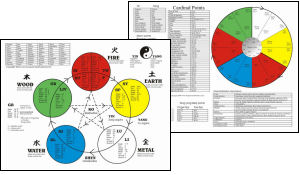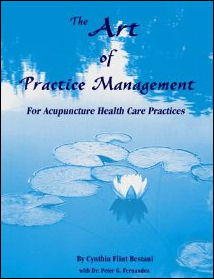Acupuncture & TCM Articles

Neil R. Gumenick is the founder and Director of The Institute of Classical Five-Element Acupuncture. Neil is a Worsley certified advanced teacher of Classical Five-Element Acupuncture and a practitioner with over 27 years of private practice experience. Neil holds three degrees from the College of Traditional Acupuncture (U.K.), and he participated for 10 years in the Master Apprentice Programô, led by Profs. J.R. & J.B. Worsley. Neil has taught at the USC and UCLA Schools of Medicine, the Worsley Institute of Classical Acupuncture, the Traditional Acupuncture Foundation, California Acupuncture College, Santa Barbara College of Oriental Medicine, and Pacific College of Oriental Medicine. He has been a Professor at Emperor's College of Traditional Oriental Medicine and SAMRA University of Oriental Medicine. Neil is co-author of The Art of Practice Management for Acupuncture Health Care Practices
Practitioner/Patient Rapport, Part II
By Neil Gumenick, MAc (UK), LAc, Dipl. Ac
To truly gain Rapport is unity with a patient or anyone else. It stems from knowing that all human beings are, in essence, equal. When you are with a patient, you are with an equal - a sick and imbalanced one, perhaps, but at the core, equal.
Therefore, when you are in rapport with a patient, your personal process is put to one side, and you are empty enough to resonate to the patient's vibration and respond to his or her needs. You are really becoming conscious of what you feel inside yourself being with this other person. What "jars" you repeatedly will be the patient's energetic imbalance crying out. Recognizing this is one of the pillars of diagnosis of the causative factor, or underlying elemental imbalance. Regardless of what system you practice, establishing rapport is essential in gaining the patient's confidence; acceptance of your treatments; compliance with your recommendations; and referral of other patients.
When you are in rapport, there is no "I" thinking, striving, analyzing. When first seeing a patient, this means that you cannot assume anything -- that you can get the patient well or that the patient wants to get well - because you do not yet know it. Be curious as to what the patient is asking for, not just in words, but in the sound of the voice, emotion, posture, facial expression, and the response to the various things you do. Does the content seem appropriate to the manner in which the patient expresses it?

Case Study
The patient was a nine-year old boy. He presented with a very sad face; he was ashen gray, and he slumped in his chair. I asked him what I could help him with. He responded that he didn't know. I asked him if that meant he was doing just fine. He responded "Yeah," with absolutely no lift, joy or enthusiasm.
Consider how inappropriate that sound was to the content. When someone is really doing fine and answers "Yeah," I would expect there to be some degree of joy confirming how fine things truly are. Here, in one word, was a wealth of diagnostic information gleaned from how that word was said. Following this, there was virtually the same non-responsiveness to any direct questions.
Suddenly, I was moved to begin clowning with him. Speaking in the voice of a cartoon character, I laughingly took him by the hand and gave it a vigorous shake. "Aw, c'mon now! It can't be as bad as all that!" His eyes opened wide, and he came alive with a cartoonish voice of his own. I kept emotionally exaggerating, entertaining him - feeding his fire - and he lit up. Soon, our laughter echoed throughout the clinic. I was not forcing myself to be entertaining. This arose in me out of the patient's need for this kind of expression. I was then able to shift out of clown mode and ask the boy about himself. He was eager to share with me. We had shared something essential - joy and laughter - and he trusted me.
His life, I learned, had been very barren in terms of fire. His parents had just separated after years of turmoil in which he was deprived of the fire he so desperately needed. He stiffened slightly when I got too physically close (such as putting my arm around his shoulder). He was not ready for that. How did I know? I tried it. He didn't like it, so I knew not to do that yet. Several treatments later, he was quite accepting of that contact, showing the level the treatments were reaching. Regardless of his surface symptoms (which did improve), I knew he was getting well on a deep level because he was able to take in more contact. On this first visit, though, light, good-humored interaction was exactly what he needed for rapport. It touched his spirit. It also confirmed fire as his underlying elemental imbalance, or causative factor (along with his facial color, sound and odor).
The child left the treatment room quite transformed, to the amazement of his mother, who remembered a very different little boy an hour earlier. She tells me how he absolutely loves coming for treatment and wouldn't miss it for the world. Why? Because with me, he gets the laughter, joy and love that he gets nowhere else (and that he so desperately needs). As treatment progressed, this carried over into more areas of his life as he carried more of the fire within himself.
Obviously, the foregoing case is not a formula for how to behave with all depressed patients, but an example of how we can elicit and respond to a patient's needs. If we do not make rapport, contact and penetrate the inside of a patient's mind and spirit, we may never get them well in spite of accurate diagnosis, point location, and all other technical aspects. Out of rapport can come good diagnosis and treatment, not the reverse. We meet real needs, not assumed needs. We must be clear about what we are feeling from the patient as well as what we are providing emotionally for the patient, and what the patient's response is. The more we perceive the need, the better we can select points, and the more receptive the patients will be to treatment.
Admittedly, this is the most difficult thing we are asked to do as practitioners. It is far more difficult than memorizing formulas, points or syndromes. To develop the ability to become one with any patient in mind and spirit requires developing our senses; keeping our intellects uninvolved; and transcending our own imbalances which have locked us into particular ways of being and relating. We may also be insecure about patients liking us, so we do not leave the safe realms of what is comfortable for us, yet some other mode of relating may be just what another patient needs. As an exercise, imagine leaving your personal process outside the treatment room as you touch the doorknob to enter.
Rapport with the Patient's Fire Element
All people need and want the gifts of the fire element: warmth; laughter; to love and be loved. The state of a person's fire determines how much he or she can handle. The fire may be damaged so that the patient is incapable of giving or receiving joy or warmth and cannot laugh or be joyous. On the other hand, it may over-express inappropriately. The patient with a fire imbalance may crave closeness or flatly reject it because he or she is just too vulnerable. As the practitioner, you must bring forth this emotion to some degree in order to know. This is the yin/yang of rapport: at times, you must be empty and listen; at times, you must be active and elicit (providing a springboard for emotion to show itself), then empty and listen for the response. If the rapport is broken, the fire-imbalanced person may try to recreate it because he or she does not want to lose your attention and affection. The person may fill in the broken rapport with his/her own fire (laughing, clowning, joking, entertaining), or the person may just drop sad and empty, like a fire flickering out, leaving you to reignite it.
If you give joy, does the patient give it back? What happens if you stop? Can the patient maintain joy on his or her own? Go close, then withdraw. Do not talk only with your mouth. Bring your whole self. Use your hands. Touch the affected area of complaint. This acknowledges and connects you with the patient. Then, let go. What happens? Move in closely with your voice (softly and slowly), your emotions, your body. Don't give a mixed message. If your tone of voice is saying "Come closer," you should not be at a physical distance or in a closed posture that says, "Stay away." If you do consciously withdraw your fire, don't stay away too long. Note the response and go back toward the patient. Change! Vary your speed, volume and tone. Don't stay at one vocal, emotional or physical level too long. Once you have found what a patient likes and needs, you know where "home base" is. You can then lead or follow the patient in any direction, and you will always be able to recreate rapport.
Crack a joke. Is the response normal? How would you respond? Use that as your criteria to judge. Even a question as mundane as "How are your bowels?" can elicit a wealth of information about a patient's mind and spirit. Suppose the patient answers with a rather deadpan, "Oh, they're OK." Suppose you respond wildly happy with "Marvelous! Good job! We've got one system working, haven't we!" Can the patient join in the fun, or not? If not, what does the patient do? You shift into neutral and listen to where the patient leads.
Some of you are uneasy about doing what I have suggested. You imagine patients will think you are crazy. They might, but only if you stay at that level of intense joviality too long. Go for it, then back off. Consider whether your purpose to be liked, or to discover the needs of your patients and assist nature in attending to their needs. When you do the latter, they will not only like you; they will (appropriately) sing your praises as a healer.
 
The Art of Practice Management for Acupuncture Health Care Practices
What you will find in this book is a specific, comprehensive approach that gets to the root cause of success in practice.
This new book presents acupuncture practice as art from the standpoint of centering, qi, and wholeness. It builds on the premise that practices succeed from bridging inner and outer aspects of the self. It is an inquiry into the self and addresses clear understandings and approaches to reputable patient care and practice qi. It brings in the five elements and work with the seasons of practice from training and start-up to growth, stability, expansion and transformation. The authors artfully bridges the essence of both patient and practitioner well-being without excluding the practicalities of financial well-being. This book very specifically and extensively shows how the different parts of practice nourish and feed one another and are interdependent on one another for the qi to flow synchronistically.
It explores the dual nature of procedures that work and those which do not in acupuncture health care practice, returning again and again to the delicate balance of practicality and spirituality.
|
